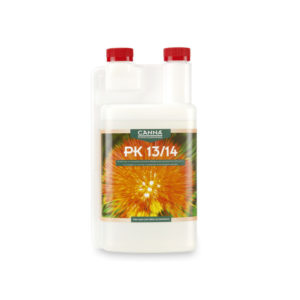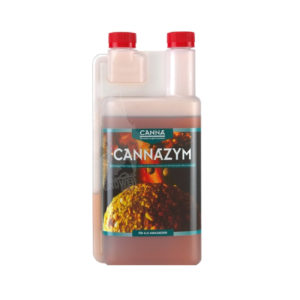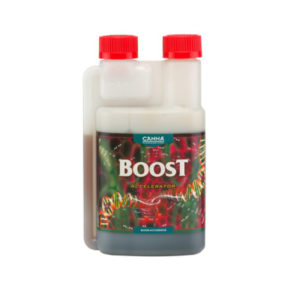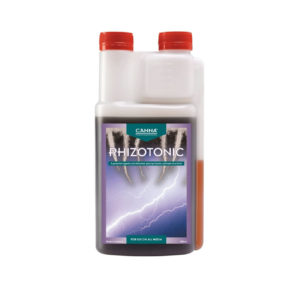Hello there, UK growers!
If you haven’t read our previous guide about CANNAZYM, check it out to discover more about the power of this enzyme product and why you need to add it to your CANNA feeding schedule.
This week we bring you a comprehensive article on CANNA PK 13/14. Hope you enjoy it and if you like it, do not forget to share with other UK gardeners who would benefit from finding more about what PK 13/14 does and when to use it.
We are back again with another article about the fantastic additives manufactured by CANNA.
What Is CANNA PK 13/14?
CANNA PK 13/14 is a flowering stimulator high in phosphorus and potassium manufactured by CANNA. PK 13/14 ensures stronger cell formation, the production of enough sugars in the flowering stage, and increases plants osmotic value which improves the volume, weight and taste of your crop.
The 13/14 ratio means that there is 130 g of phosphorus and 140 g of potassium per litre of nutrient formulation when dissolved in water. PK 13/14 is available to the plant quickly and directly.
If you haven’t previously heard about PK 13/14 or CANNA, you are missing out! CANNA is one of the most popular and worldwide-recognized manufacturers of environmentally friendly growing mediums and nutrients. Find out more about CANNA here.
Why Do Plants Need Phosphorus and Potassium?
As you already know, NPK stands for nitrogen, phosphorus and potassium. These are the three essential macronutrients needed by all plants in different amounts throughout the growth cycle.
Below we have listed some of the most important roles of Phosphorus (P) and Potassium (K) in plants growth.
Phosphorus (P) promotes plants breathing, the formation of roots, and is essential for the formation of flowers and fruits, as it aids the division of cells, growth of new tissue, and energy transmission in plants.
Potassium (K) helps move water and nutrients around in plants, helps plants make strong stems, controls the stomata that the plant uses to absorb carbon dioxide, hydrogen and oxygen from the air, and is responsible for the firmness of cell walls.
More PK In The Flowering Stage?

The bigger your plants grow, the more nutrients they need in order to sustain themselves.
And while the requirement of nitrogen (N) throughout a crop’s life cycle remains consistent, your plants require increased amounts of phosphorus and potassium (PK) as they grow and mature. This is why nutrients for flowering contain more P and K than N.
Check out these videos to find out more about phosphorus and potassium’s role in the flowering stage.
How Does CANNA PK 13/14 Work?
As CANNA wonderfully explains in their videos, in the flowering stage Phosphorus (P) is needed to build and reinforce the cell walls.

Then the water compartment in the new cells is filled with Potassium (K). This raises the EC of the plant (a.k.a. the osmotic value).

And as a result, the cell draws in more water from outside and the pressure inside the cell increases.

The fruit becomes harder and heavier.

Phosphorus (P) is also needed for the seeds to develop as it aids the transfer and storage of energy which is needed during the reproduction phase for the new seed.

Potassium (K) flows into the fruit which increases its osmotic value inside and it swells in size, volume, and weight. The fruit’s flavour is also influenced positively.

When To Use CANNA PK 13/14? Dosage & Feeding Schedule
You should only use CANNA PK 13/14 when the plants have already developed enough flowers or fruits to need the additional phosphorus and potassium.
According to the official CANNA Feeding Schedule, PK 13/14 needs to be applied for one week only (3-4 weeks before harvest).
This is due to the fact that the product is highly concentrated and your plants need time to metabolize the ingredients. In addition to that, your CANNA base nutrients already contain a certain amount of P and K, so to change the PK-ratio, without messing up the N (nitrogen) feed, you add CANNA PK 13/14 for one week.
The recommended ratio is a maximum of 15 ml per 10 Liters of water.
Make sure to check out part 2 of our Ultimate Guide To CANNA to find the official feeding schedules.
PK 13/14 Frequently Asked Questions

Yes! CANNA PK 13/14 is suitable for use in all growing mediums.
To maximize the benefits of PK 13/14, make sure to use it along with the rest of CANNA’s additives:
RHIZOTONIC – a root stimulator that helps with root development, increases plants’ strength and disease resistance.
CANNAZYM – a highly-concentrated enzyme product that targets the source and cause of root binding, dead root material and old cast off. Find out more about CANNAZYM.
CANNABOOST – a flower booster that improves the health and metabolism rate of short-cycle plants.
When it comes to NPK, you would want to avoid problems from overfeeding or underfeeding your plants. If you are feeding your plants with CANNA base nutrients, then CANNA PK 13/14 should be your go-to PK booster.
The only way to ensure the levels of nutrients and minerals are balanced and your plants are getting everything they need in the correct proportion is by sticking with only one brand of fertilisers. Check out this article by CANNA UK, where this issue is thoroughly explained.
Yes, always shake your PK 13/14 bottle well before use.
CANNA promises a shelf life of 5 years with the proper storage conditions.
To ensure the maximum shelf life, keep PK 13/14 with the lid on in a dark place and frost-proof place.
Additives To Use Alongside CANNA PK 13/14?
Get them from a trusted UK-based grow shop now! Subscribe before you buy and get your discount.
Conclusion: When To Use CANNA PK 13/14 For Maximum Yields
If you want bigger flowers, more fruit development, and a measurable increase in harvest weight… you need CANNA PK 13/14.
To get the most out of PK 13/14 use it for one week only, about 3-4 weeks before harvest when the plants have already developed enough flowers or fruits to need the additional PK.
Click on the button below to buy it now from Hydrostork – your one-stop online grow shop in the UK. We deliver all over the UK with free delivery for orders above £50.
If you would like to get more UK gardening tips and tricks, follow us on Facebook.





